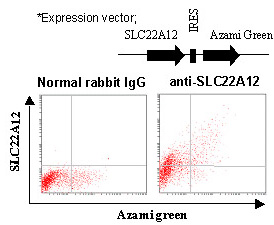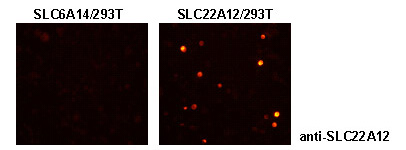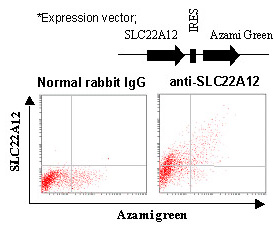Anti-SLC22A12 (URAT1) (Human) pAb
| Code | Size | Price |
|---|
| MBL-BMP064 | 50 ul | £323.00 |
Quantity:
Prices exclude any Taxes / VAT
Overview
Host Type: Rabbit
Antibody Isotype: IgG
Antibody Clonality: Polyclonal
Regulatory Status: RUO
Target Species: Human
Applications:
- Flow Cytometry
- Immunocytochemistry (ICC)
- Immunohistochemistry (IHC)
Shipping:
4°C
Storage:
-20°C
Images
Documents
Further Information
Alternative Names:
urate transporter 1, URAT1
Applications:
FCM - 1:1000 ICC - 1:1000 IHC - 1:5000 (Heat treatment required for paraffin)
Background:
SLC22A12, also known as urate transporter 1 (URAT1), is a member of the organic cation/anion/zwitterion transporter family. This transporter is present on the epithelial cells of proximal tubules in the renal cortex and mediates urate uptake. Gene mutations or functional defects of URAT1 have been identified in patients with renal hypouricemia, which is characterized by low serum urate levels. Disorders associated with this condition include uric acid urolithiasis; hematuria; hypercalcemia; or occasionally, exercise-induced acute renal failure.
Formulation:
50 ul volume of PBS containing50% glycerol, pH 7.2. No preservative is contained.
Gene IDs:
Human: 116085 Mouse: 20521
Immunogen Translated:
Synthetic peptide derived from human SLC22A12
Reactivity:
This antibody can be used to stain endogenous antigen in paraffin embedded human tissues including the kidney by Immunohistochemistry. The reactivity has been confirmed by Immunocytochemistry and intracellular Flow cytometry to detect the full length of human SLC22A12 transiently expressed in HEK 293T cells.
Shelf Life:
1 year
Source:
This antibody was affinity purified from rabbit serum. The rabbit was immunized with a synthetic peptide derived from human SLC22A12.
Target:
SLC22A12/URAT1
References
1)
Ichida, K., et al., Clin Genet 74, 243-251 (2008)
2)
Thangaraju, M., et al., J. Biol. Chem. 281, 26769-26773 (2006)
3)
Wakida, N., et al., J. Clin. Endocrinol. Metab. 90, 2169-2174 (2005)
4)
Tanaka, M., et al., Am. J. Kidney Dis. 42, 1287-1292 (2003)
5)
Enomoto, A., et al., Nature 417, 447-452 (2002)








